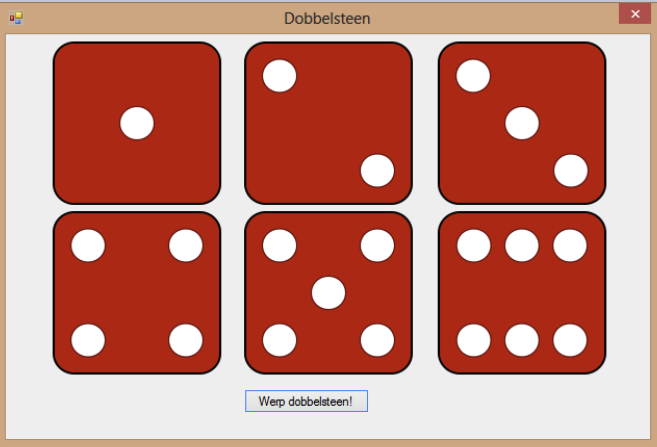FontysICT-sem1
Training - Dices and Randomness
If you want to program a game, even the simplest games (tic-tac-toe) encounter the problem: how do I program randomness? How do I make a random move? How do you program that?
To experience this, you will write a small program that simulates the random behavior of a dice. If this so-called “proof-of-concept” program works, you will have a better understanding of how to consider the necessary randomness during design and have more certainty about the game’s chances of success.
Assignment
Create a user interface with 6 picture boxes and a button that looks like this:

There are six objects of type PictureBox and a “Roll dice!” button on the form. The PictureBox objects are all invisible when the program is running (the Visible Property is set to false).
The goal is that every time the “Roll dice!” button is clicked, exactly one random PictureBox becomes visible. The other picture boxes become invisible. Program this functionality.
Extensions
- Level * - Place all PictureBox objects exactly on top of each other (so it looks like the same dice is being rolled again each time).
- Level ** - Use a single switch statement (tip: Search the internet for a source) instead of multiple “if … else …” statements.
Checklist
If you have completed the assignment correctly, you have met the following points:
- When the program starts, no dice images are visible.
- When the button is pressed, exactly one dice image becomes visible.
- When the button is pressed again, exactly one image (this may happen to be the same one) of a dice becomes visible.
- If you click the button dozens of times in a row, you will see the images for dice 1, 2, 3, 4, 5, and 6 shown at least once.
- If you click the button dozens of times in a row, two images are never shown at the same time.
- You have not used more “if … else …” constructs than necessary.
- You have code lines in each “if … else …” construct in the “if” block.
- You have code lines in each “if … else …” construct in the “else” block or you have omitted the “else” block.
- Extension a: Regardless of the value rolled, the image with the number of eyes is always shown in the same place.
- Extension b: Besides the “switch” statement, you have not used any more “if … else …” statements and you have not used a “default” case within the switch statement.